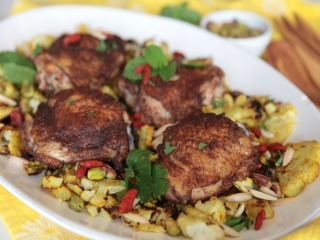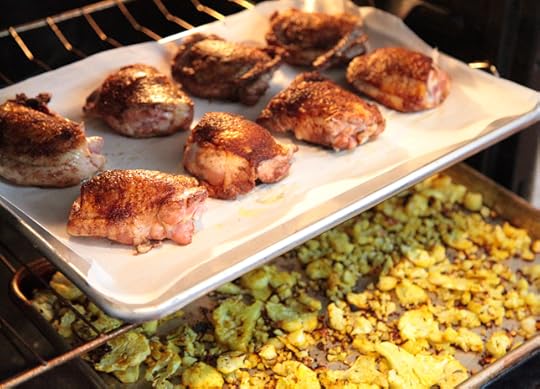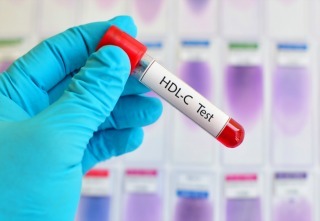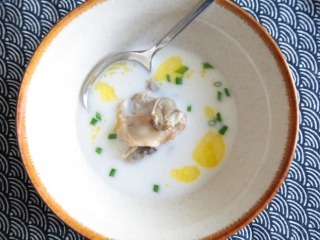Mark Sisson's Blog, page 198
January 1, 2017
Weekend Link Love – Edition 433
 RESEARCH OF THE WEEK
RESEARCH OF THE WEEKLeg pressing improves balance more than squatting (though both are effective).
Creatine emerges as a novel treatment for Crohn’s disease.
Endurance training trains the brain.
Inuit cold tolerance may have come from the Denisovans.
Broccoli could head off depression.
NEW PRIMAL BLUEPRINT PODCASTS

Episode 149: Arriane Alexander: Elle Russ chats with Arriane Alexander, a “rock your life coach” and actress who helps women discover their dreams, lay the foundation necessary to realize them, and succeed on the journey to their new lives.
Each week, select Mark’s Daily Apple blog posts are prepared as Primal Blueprint Podcasts. Need to catch up on reading, but don’t have the time? Prefer to listen to articles while on the go? Check out the new blog post podcasts below, and subscribe to the Primal Blueprint Podcast here so you never miss an episode.
A Primal New Year’s Eve Survival Guide
My Experience With Exogenous Ketones: Tale and Truth
INTERESTING BLOG POSTS
“In short, avoiding the sun is as bad for you as smoking.”
Regarding a year of (almost exclusively) bodyweight training.
MEDIA, SCHMEDIA
Grain-producing regions of the world may soon run dry. Get them some holistically-managed ruminants!
Could using genetic engineering to eliminate neurological diseases also eliminate genius?
EVERYTHING ELSE
Bats like to argue about almost everything.
THINGS I’M UP TO AND INTERESTED IN
Announcement I’d like to make: Primal Kitchen, Primal Kitchen Restaurants, and Primal Health Coach will all be at TheFitExpo, coming Jan 7-8 (next weekend) in Los Angeles.
Older study that I liked: A high-SFA, no-starch diet rich in fruit increased weight loss and improved blood lipids over 52 weeks.
Concept I’m pondering: Does the mind extend beyond the body?
Something non-obese perhaps shouldn’t do: Fast for two weeks.
Doctor who got it: This guy.
RECIPE CORNER
Stack your scallops with bacon.
How Magnus Nilsson cooks 5 month-aged steak.
TIME CAPSULE
One year ago (Jan 1 – Jan 7)
The Definitive Guide to Using Your Recent Ancestry to Determine Your Optimal Diet – How and why your ethnicity might affect your optimal lifestyle.
10 Ways to Make Every Day a Window for Change – Seize the days.
COMMENT OF THE WEEK
“You don’t like the Udi’s Gluten-Free crumble cakes that they call bread? :O”
– Amen, zach rusk. Gluten-free bread is the best argument against bread consumption.
Happy New Year, everybody! I’m looking forward to digging into 2017 together. And FYI: our annual 21-Day Challenge begins January 9. Look for more info this week!

The post Weekend Link Love – Edition 433 appeared first on Mark's Daily Apple.



December 31, 2016
Roasted Persian Chicken and Cauliflower
 In this Persian-inspired recipe, chicken and cauliflower are perfumed with saffron, cinnamon, cardamom, turmeric, black pepper and other spices, then roasted until crisp. The cauliflower is dotted with goji berries, pistachios and slivered almonds, and the chicken is finished with a dusting of parsley and mint. Combined, this is a fragrant, deeply flavorful meal.
In this Persian-inspired recipe, chicken and cauliflower are perfumed with saffron, cinnamon, cardamom, turmeric, black pepper and other spices, then roasted until crisp. The cauliflower is dotted with goji berries, pistachios and slivered almonds, and the chicken is finished with a dusting of parsley and mint. Combined, this is a fragrant, deeply flavorful meal.
This richly spiced dish isn’t just flavorful though. The spices also contribute antioxidants and protection against microbes. This recipe gives measurements for both whole and ground spices – you can choose which to use. Buying whole spices and grinding them (a coffee grinder works well) often means more potent flavor and health benefits. Pre-ground spices are more convenient. Just make sure they’re organic and less than a year old.
Time in the Kitchen: 1 hour 15 minutes
Servings: 4
Ingredients

Chicken
6 to 8 bone-in, skin-on chicken thighs
1 tablespoon cumin seeds, or 1 tablespoon ground (15 ml)
1 tablespoon coriander seeds, or 1 tablespoon ground (15 ml)
4 whole cardamom pods, or ¼ teaspoon ground (1.2 ml)
1-inch/2.5 cm piece cinnamon stick, or 1 teaspoon ground (5 ml)
1/2 teaspoon ground allspice (2.5 ml)
1/4 teaspoon ground black pepper (1.2 ml)
1 teaspoon kosher salt (5 ml)
Cauliflower
1 head cauliflower, halved, cored, and thinly sliced
1/4 cup extra virgin olive oil (60 ml)
1/4 teaspoon saffron threads, crumbled pepper (1.2 ml)
1/2-inch piece cinnamon stick
1/4 teaspoon ground pepper (1.2 ml)
1 teaspoon cumin seeds, or 1 teaspoon ground (5 ml)
1/2 teaspoon ground turmeric (2.5 ml)
1/4 teaspoon ground black pepper (1.2 ml)
1/2 teaspoon kosher salt (2.5 ml)
1/4 cup goji berries, soaked in warm water for 5 minutes and drained (30 g)
1/3 cup slivered almonds, raw or lightly toasted (50 g)
1/4 cup raw pistachios (40 g)
1/4 cup finely chopped parsley (60 ml)
1/4 cup finely chopped mint (60 ml)
Instructions

Preheat oven to 425º F/218 C.
In a small bowl, mix together the ground spice blend for the chicken: cumin, coriander, cardamom, cinnamon, allspice, black pepper, salt. *
*If using whole spices, first grind the cumin seeds, coriander seeds, cardamom pods and cinnamon stick in a coffee grinder until finely ground
Rub the spice blend into the chicken pieces.
In a 10- or 12-inch cast iron skillet, heat about a tablespoon of avocado oil or extra virgin olive oil over medium-high. When the oil is hot, brown the chicken in batches so the skillet isn’t too crowded. Cook 3 to 5 minutes on each side, until skin is starting to get crispy and golden brown.
Place all the chicken on a rimmed baking sheet and set aside.
To make the cauliflower, first warm the olive oil in a small pot. Pour the warm olive oil in a bowl and add the saffron. Let sit 5 minutes.
In a large bowl, pour the saffron oil over the cauliflower. Toss well.
In a small bowl, combine the spice blend for the cauliflower: cinnamon, cumin, turmeric, black pepper and salt. *
*If using whole spices, first grind the cinnamon stick and cumin seeds in a coffee grinder until finely ground.
Sprinkle the spice mixture over the cauliflower, tossing to evenly coat.
Spread the cauliflower out evenly in one layer on a rimmed baking sheet. If one baking sheet is crowding the cauliflower, then use two baking sheets so it can be spread out more.
Put the baking sheets of chicken and cauliflower in the oven. Bake 25 to 35 minutes, until the internal temperature of the chicken reaches at least 165º F /74 C and the cauliflower is darkly browned around the edges.
Toss the cauliflower with the goji berries, almonds and pistachios. Spread out on a platter, and lay the chicken on top. Sprinkle parsley and mint over everything.


The post Roasted Persian Chicken and Cauliflower appeared first on Mark's Daily Apple.



December 30, 2016
I Feel Outstanding and Am in Control of My Relationship with Food
It’s Friday, everyone! And that means another Primal Blueprint Real Life Story from a Mark’s Daily Apple reader. If you have your own success story and would like to share it with me and the Mark’s Daily Apple community please contact me here. In fact, I have a contest going right now. So if you have a story to share, no matter how big or how small, you’ll be in the running to win a big prize. Read more here.

Hi, I’m Sarah, and I am 39 years old. I’ve always been interested in science. I loved the experimentation, tweaking little things and the precision required. I studied biochemistry at university and started working in a lab diagnosing illnesses, and later doing cancer research. I moved away from it as a career, but I became interested in nutrition and exercise, trying different ways of eating and training to lose weight for my wedding. I found some that worked – but were really hard going and just not sustainable. As soon as I married I started to put weight on again.
We had two children in a year, which was amazing – but a huge challenge, and I had literally no time for myself. My health suffered, and I ate really poorly, literally living on chocolate spread sandwiches and other easy processed food. I binged on sweets and chocolate almost every day, feeling out of control of my cravings. Over a couple of years I added to the weight gain, topping out at 195 pounds. I was disgusted with myself.
I hit a low when I ordered a pair of 16 (US size 14) trousers online, and they didn’t fit. My legs rubbed together when I walked. I had a photo taken for my passport, and my face looked like a moon. I knew I had to act.
I started attending aerobic classes twice a week, and tried juicing. The weight did start to come off slowly, but it was hard going, and I felt really hungry and unstable on the juices. I looked for a better way.

I stumbled onto the 21-Day Total Body Transformation book on Amazon, and thought I would try it, although the “Primal” thing seemed fairly extreme at the time.
I felt pretty awful and had some really bad headaches the first week, detoxing all the sugar out of my system and becoming a “fat burning beast.” The food was completely different from what I had been used to eating.
After a few weeks I started to feel outstanding. More energy, more connected to my body, and the weight started to fall off without getting hungry at all. I started lifting weights, and walking all the time. We are fortunate living in Surrey (UK) – there are lots of forests and countryside on our doorstep. I would just find myself breaking into a sprint in the rain and feeling crazy and free – grinning like a loon.
My husband and I decided to completely revaluate our lives. He gave up his corporate job, and we set up a personal training company – I was his first client!
I lost four stone over two years, and have maintained at around 140 pounds. I have a condition called Endometriosis, which from me caused crippling period pain a couple of days of the month. I had no idea that sugar and refined carbs cause systemic inflammation – cutting these out mean I generally get by each month without even taking an ibuprofen. I also very rarely get sick – despite 2 children bringing bugs home from school. I don’t crave sugar anymore and feel in control of my relationship with food.
I find it hard not to preach to my friends about the lifestyle – but I want to pay it forward. So I studied Nutrition and Weight Management, and became a certified Primal Health Coach. I wanted to help people who were like me – busy, stressed, overweight, with nagging health issues, just feeling “blah” all the time.
I turn 40 this year, and am in better shape now than I have ever been in my life. Adopting the Primal lifestyle has made such a difference in my health, outlook and well-being that I am really thankful – and will try to help other people achieve the same.
Sarah
For more information on Primal Health Coaching with Sarah, visit her website.


The post I Feel Outstanding and Am in Control of My Relationship with Food appeared first on Mark's Daily Apple.



December 29, 2016
Dietary Trends: Are Popular Interests Inching toward Ancestral Wisdom?
 As the calendar draws toward the close of another year, I’m inclined to take stock of where the Primal vision stands. Are people slowly warming to the idea of Primal eating (and living), or are we merely seeing inconsequential, lateral shifts within the same old confines of conventional grain-based, saturated fat-averse, dietary “wisdom”?
As the calendar draws toward the close of another year, I’m inclined to take stock of where the Primal vision stands. Are people slowly warming to the idea of Primal eating (and living), or are we merely seeing inconsequential, lateral shifts within the same old confines of conventional grain-based, saturated fat-averse, dietary “wisdom”?
All right, all right. It’s fair to say that, without examining the numbers, the majority of people are still stuck in their same detrimental ways. But are the cracks in CW I noted a few years ago deepening and expanding? If we look closely enough, could there be a bit of whole-food common sense shining in there? Or is it just some refracted marketing gloss that catches the right angle from time to time? Or just wishful, starry-eyed delusion?
All good questions with their own claim on truth. Still, are there any substantive takeaways from 2016? And how are things shaping up for the next year at that? Let’s take a brief look.
2016 in Review: Where did Grok fit in?
Last month, Google released its report on 2016 Food Trends. (PDF) With its window into public curiosity, it gives us a refreshing take on how the (Internet-connected) world views food, highlighting popular interests rather than dietitian recommendations. And while I’m always a little hesitant to jump into the brain of your average calorie-counting consumer, it’s useful to get an overall idea of what people are thinking with regards to food.
For one, it appears “gluten-free” is dropping in the charts. With Google reporting a decline in searches for “Gluten Free Cupcakes” and “Wheat Free Bread,” it appears that perhaps the average Joe/Jane has lost interest—at least in non-gluten bake goods. (Somehow I’m not too optimistic that they’re being replaced with the likes of Primal stew and Big A$$ salads.)
There was also a significant decline in interest for classic “healthy” examples of kale chips, quinoa, and agave nectar (sorry, there’s no such thing as guilt-free).
But enough of the “has-beens”…. What about the up-and-comings of the great Google food query?
It appears that the world’s love affair with pasta, bread and rice continues to flourish. Of the 7 Sustained Risers of the 2016 Google food search, 3 fit the pasta category (ramen, rigatoni and linguine), 2 relate to wheat and baked goods (empanadas, bundt cakes), and 1 was a rice-heavy (but admittedly delicious) Korean dish (bibimbap). I have to say that, minus the bibimbap, I’m a little disappointed.
Uncured bacon was a slightly promising trend. I wouldn’t have put that at the top of the concern list, but maybe beggars can’t be choosers.
Still, credit to Internet searchers everywhere, there were some genuine bright spots. According to Google, the new rising stars of the food world include turmeric, jackfruit and cauliflower rice. I’ve shared my thoughts on turmeric recently. I hear jackfruit is a superfood contender—and a sustainable food source to boot. Cauliflower rice has long been a staple for many in the Primal/paleo and low-carb crowds.
So, a few wins here, and a few losses there. I like to think that we all got something out of the trendy gluten-free stint though. While searches might be down, I don’t think there’s any going back to total denial at this point. And from where I’m sitting, the market has been changed by gluten-free “fadism”—for the better. (Just don’t fall for the gluten-free sugar.)
The “experts'” crystal ball…Hints for 2017?
Despite some of the aforementioned dietary pivoting, Americans will plunge into 2017 with a bit more food know-how under their belts. While the “gluten-free” movement may appear to be losing some steam, there’s undeniably a growing recognition of food as medicine.
Four of the top five “health benefits of”-type Google queries of 2016 related to apple cider vinegar, coconut oil, cinnamon, and bone broth. Now we’re cooking with gas.
The final query in that grouping was “health food stores near me,” suggesting that more people are actively seeking out sources for nutrient-dense, minimally-processed foods. Who knows? Maybe a few of them stumbled on Thrive…or PRIMAL KITCHEN™ in the process.
This newfound food research fanaticism may or may not guide people towards a more Primal way of eating. To get a glimpse of the not too distant edible future, I’ve skimmed some of the more notable predictions for 2017 floating around the net. Here’s a small taste:
Plant-based protein will be all the rage.
Apparently 2016 was the International Year of Pulses. Who knew? It certainly did see a return of the legume back to the kitchen table—even among the Primal and paleo circles. Personally, I’ve got no beef with legumes. I’ll throw them in for taste and texture sometimes. That said, I wouldn’t ever depend on them for my protein base. Sure, there’s nutrition there, in some more than others, but let’s be honest, too—the carb count hasn’t changed.
Brace yourself for an onslaught of beans in the coming months, people.
(Good) fats may catch a welcome reprieve.
At last, a prediction to truly get excited about! After a casual 4-plus decades of hating on fat of any kind, the U.S. Dietary Guidelines Advisory Committee has grudgingly admitted that certain fatty foods may in fact not be the devil incarnate. Avocado, almonds and salmon all get the thumbs-up from these dietary sticklers, which may herald a new golden age for the fat-starved masses. Grok’s nodding in approval.
But don’t be fooled: most dietary bigwigs are still convinced that fat is the enemy. A skim (pun intended) through the 2015 Dietary Guidelines reveals an immovability with regard to saturated fats, and I don’t think a year has done much to budge them. Note that we’re still getting the same old recommendations for “fat-free or low-fat dairy, including milk, yogurt, cheese, and/or fortified soy beverages.” Here I was thinking we’d finally hit a home run.
Progress: We’ll take it where we can get it.
Despite the apparent dietary see-sawing, maybe it’s not too much to suggest there’s less disagreement when it comes to what constitutes healthy eating. Those who are willing to do the research agree that low/moderate carbs and high fat are good, as long as it’s healthy fat. The rising stars of 2016 showed that nutrient density is quickly becoming a benchmark for healthy eating, along with the growing notion that maybe eating so much sugar isn’t the best decision ever.
If ancestral logic isn’t getting the credit, it’s perhaps because we remain uncomfortable looking to our uncivilized past for direction. As a tech-savvy consumer society, most people prefer to believe sources for dietary wisdom are situated in cutting edge science rather than innate sense. We’re more inclined to trust “progress” than history.
Still, if popular interests and, brace yourselves, conventional wisdom are indeed inching toward ancestral principles (even as they disown them by name), the overall direction perhaps creates new entry points for more folks to discover a larger picture of health in the Primal Blueprint or paleo models.
And, btw, let’s not overcomplicate things.
All said, it’s refreshing to see an increase in people actually showing some degree of consciousness regarding the ingredients in their food. Yet, it’s also frustrating to discover that most people still believe being healthy is hard. Among the commentary and observations offered with the report is the notion that “to eat healthy, you have to pay a lot of attention.” To me, we walk a fine line with these kinds of statements and may actually deter people from trying to get healthy in the first place.
People think that eating healthy is complicated, that the rules change all the time, and the mainstream media chronically perpetuates this misconception.
That’s the beauty of ancestral logic. The Primal Blueprint diet is, at its core, very simple. Healthy fats, fresh produce, high-quality meats. It’s not rocket science, and that’s why it works. Perhaps 2017 will see a continuing shift towards dietary simplicity. For the sake of public health, I certainly hope so. I’m ready to do my part.
Thanks for stopping by everyone. Is there anything food-related that’s made a big difference to your life in 2016? What are your predictions for popular food trends in 2017?
Happy holidays, and I’ll see you in the new year!

The post Dietary Trends: Are Popular Interests Inching toward Ancestral Wisdom? appeared first on Mark's Daily Apple.



December 28, 2016
A Primal New Year’s Eve Survival Guide
 New Year’s Eve approaches. Parties beckon. Arsenals of alcohol accumulate. Whether you venture out into the wild night or keep it quiet with close friends and loved ones (that’s me), people will probably offer you a glass (or several) of something containing ethanol to mark the occasion. As always, it’s not about a right or wrong choice but about assuming responsibility for your health. I’ve heard a lot of readers over the years say going Primal has made them much more sensitive to the effects of alcohol. If you’ll be partaking, you can gird your system to deal with the incoming toxicity.
New Year’s Eve approaches. Parties beckon. Arsenals of alcohol accumulate. Whether you venture out into the wild night or keep it quiet with close friends and loved ones (that’s me), people will probably offer you a glass (or several) of something containing ethanol to mark the occasion. As always, it’s not about a right or wrong choice but about assuming responsibility for your health. I’ve heard a lot of readers over the years say going Primal has made them much more sensitive to the effects of alcohol. If you’ll be partaking, you can gird your system to deal with the incoming toxicity.
Now, a word of caution. This protocol may very well make you feel invincible. It might even reduce the deleterious effects and increase the pleasurable effects of alcohol. That doesn’t mean you should drink more. Keep it moderate. Maintain the buzz. If you go further, however, I can’t vouch for your safety.
In the Days Leading up to the Party
Sleep well. Remember how every tissue in your body has a circadian clock keeping rhythm? For you organs to work properly, you need to sleep well and sleep consistently. New Year’s Eve throws that into disarray, so in the days leading up to a late night proper sleep hygiene is vital. Don’t mess this up.
Limit omega-6 fats, emphasize MUFAs and SFAs. Animal study after animal study each confirm that high-O6 PUFA feeding increases liver damage in response to ethanol, while more stable fats like cocoa butter and coconut oil protect against it. And if you do eat omega-6s, make sure they’re in whole food form (nuts, seeds, eggs, etc).
Day of the Party
Train hard and go for a brisk walk. Exercise up-regulates antioxidant activity and, at least in rats, actively reduces alcohol damage.
Eat five egg yolks or some liver. Your liver will be burning through its choline stocks, so be sure to top them off. Choline supplementation will also work well here. Choline is so important for alcohol metabolism that it can even protect fetuses against maternal alcohol ingestion (not that I’m recommending alcohol use while pregnant).
An Hour before the Party
Eat a teaspoon to a tablespoon each of extra virgin avocado oil, extra virgin olive oil., and red palm oil. The polyphenols in EVOO and avocado oil and the vitamin E in red palm oil protect against alcohol-induced oxidative stress, and the monounsaturated and saturated fats in all three protect the liver against alcohol-induced injury.
Eat a light-to-moderate meal. You want food in your stomach to slow the absorption of alcohol. If you flood your body with too much ethanol too fast, the conversion into highly toxic acetaldehyde will overwhelm your antioxidant defenses. Make sure you salt your food.
Take n-acetyl cysteine (600 mg) and vitamin C (1 gram). NAC is a precursor to glutathione, the premier antioxidant responsible for metabolizing alcohol. Hospitals give NAC megadoses to prevent Tylenol liver poisoning. Vitamin C helps NAC supply glutathione.
Take 200-400 mg magnesium. Alcohol depletes magnesium (it’s actually how we become tolerant to alcohol’s subjective effects)
Eat a few squares of high-cacao dark chocolate. Not only does the cocoa fat protect against ethanol-induced liver injury, the cocoa polyphenols increase your antioxidant capacity.
Eat some polyphenol-rich plants and spices. Turmeric, ginger, berries, beets. Anything pungent and/or colorful will be good for your alcohol metabolism. But don’t stack all of the spices and plants. Much of the benefit comes from hormesis, or the beneficial response to acute stressors. Eating a tablespoon of turmeric, a pound of blueberries, a carton of raspberries, a handful of goji berries, and two inches of ginger root might be too much of a good thing.
Have a cup of green tea. Green tea contains polyphenols that protect against ethanol-induced oxidative stress.
Eat collagen. The glycine in collagen/gelatin reduces lipid peroxidation and antioxidant depletion in the livers of ethanol-exposed rats. Hmm…maybe this is the perfect time for a PRIMAL KITCHEN™ collagen bar.
During The Party
Drink the best alcohol you can access. I’m talking about Dry Farms wine. I’m talking about $40+ scotch, tequila, and rum. Avoid plastic bottle vodka and $8 tequila.
Dilute your wine with sparkling mineral water. Unwatered wine was for barbarians, according to the Romans, and they were onto something. Not only does watered wine improve your hydration, I find it can actually accentuate some of the more subtle flavor notes on a good red.
Drink NorCal margaritas. Robb Wolf’s creation is a legitimately great drink, combining high quality tequila, fresh lime juice, sparkling water (Gerolsteiner!), and salt. This same basic formula—citrus, salt, mineral water—will work with most liquors.
Drink a glass of water (ideally mineral) with a pinch of salt for every drink you consume. Stay hydrated.
Right before Bed
Mix 1/2 tsp sea salt, juice from one lime or lemon, 1 T blackstrap molasses, and 12 ounces water (again, preferably mineral or coconut). Drink 30 minutes before bed to give yourself enough time to urinate.
Eat 200 mg magnesium. More magnesium always helps.
Eat a banana with salty nut butter. It might even be time to pull out the tub of peanut butter. Dodge the lightning bolts the paleo gods will certainly send your way.
Take 3 mg melatonin. Alcohol reduces melatonin secretion (PDF), which contribute to early awakenings. Don’t worry about taking melatonin late at night in discordance with your regular circadian rhythm. This one time it’s about improving your sleep and reducing alcohol-induced oxidative stress (which melatonin fights).
In the Morning
You should be feeling great. If not, here’s what to do.
Drink the pre-bed drink from last night. Mix up another batch and send it down the hatch.
Eat two charred corn tortillas with salted butter. Charred starch provides an activated charcoal effect. It seems to “soak up” any residual toxins floating around. Some say burnt toast works well, but the last thing I want to introduce to an upset hungover stomach is a big dose of gluten. Slap those tortillas directly over a gas flame until they singe and blacken on both sides. Spread with a little butter and eat. Maybe serve with eggs.
Activated charcoal would probably work, but I like getting something to eat.
Sprint. Go do something—anything—that gets you sweating. Do that, come home, hop in a really hot shower followed by 30 seconds to a minute of cold water, and you’ll feel right as rain.
This may seem like a lot to do, but consider the alternative. It’s your day-after and health at stake. And as a one-time, one-off thing, it really isn’t a big hassle for the benefit. If you find yourself resorting to this guide on a regular basis, however, you’re probably drinking too much.
Thanks for reading, all, and if you do try it this coming NYE, let me know how it worked! And take a moment to share your own tips and tricks for party survival.
The post A Primal New Year’s Eve Survival Guide appeared first on Mark's Daily Apple.



December 27, 2016
My Experience with Exogenous Ketones: Tale and Truth
 I woke up the morning of the ceremony with butterflies in my stomach. I’d done the necessary prep. I’d abstained from carbs the past week and food the past 24 hours. I’d performed four consecutive full-body circuit workouts to deplete muscle glycogen, and undergone a liver biopsy to confirm full depletion of liver glycogen. I wasn’t taking any chances. Although I had extensive experience generating endogenous ketones and subsisting on my own body fat, exogenous ketones were another matter entirely. You don’t want to mess around with a holy sacrament without doing due diligence.
I woke up the morning of the ceremony with butterflies in my stomach. I’d done the necessary prep. I’d abstained from carbs the past week and food the past 24 hours. I’d performed four consecutive full-body circuit workouts to deplete muscle glycogen, and undergone a liver biopsy to confirm full depletion of liver glycogen. I wasn’t taking any chances. Although I had extensive experience generating endogenous ketones and subsisting on my own body fat, exogenous ketones were another matter entirely. You don’t want to mess around with a holy sacrament without doing due diligence.
Holy sacrament? Yes.
According to ethnographic accounts from early Arctic explorers who encountered the sacred compound, the exogenous ketone was developed by traditional peoples of the wintry north. No one’s quite sure where it arose first—Siberia, Greenland, Alaska, Lapland. What they do know is that these societies revered the type 1 diabetic, a rare find in the pre-contact Arctic. Using an admittedly grisly and cruel process, these groups would starve the tribe’s diabetic to induce ketoacidosis, harvest the ketone-rich urine, and reduce it slowly to a ketone-rich tar over a wood fire. Tribe shamans would dissolve the tar in pine needle tea and distribute it to members exclusively before hunting trips, warfare, and any other activity requiring optimal physical and mental function to boost energy and improve performance. As Mark Twain famously quipped, “The strongest coffee I ever had was a Laplander’s piss.”
So when I showed up to the small building on the edge of town on a rainy evening, I was anxious. What was I in for? The solemn countenances worn by my two guides for the day—Dr. Peter Attia, wearing dark robes and swinging a thurible loaded with burning MCT oil, and Gary Taubes, face smeared with bacon grease, body adorned with wreaths of stevia leaf—impressed upon me the import of the approaching ceremony.
Detractors are scoffing already. “Sisson, you’re degrading yourself taking the shortcut to ketones with a pill. Instead, spend years sweeping the ashram, maintaining a low-carb, high-fat diet, and doing low-level aerobic activity just shy of the anaerobic threshold to boost mitochondrial fat-burning capacity and generate ketones on command. There are Sami gurus who can produce so many ketones in their saliva that a single French kiss from one will boost your IQ one standard deviation for a day. That’s true power—freedom from reliance on a ketone powder.”
Maybe so. But as I said, I’ve been there already. I’ve lived that life for more than a decade. I’ve long been convinced of the merits of a fat-based metabolism, and now I wanted to push the boundaries. To build on the existing scaffolding.
So I took the ketones, Jimmy Moore effigy made of coconut husks and pork rinds looking on.
All the universe unfolded before me. I was discovering solutions to long-standing problems—business disputes, moral quandaries, plans for the future—before consciously considering them. I’d think about a problem and discover my ketone-enhanced brain had already solved it. If I closed my eyes, I could actually hear the whirr of my mitochondria churning through all the additional ketone bodies. I flung open the temple door and practically sprinted through the hills, covering five miles at 4:15 per without breaking the anaerobic threshold and returning only to purge through both ends.
“All part of the process,” Attia said, handing me a bucket and washcloth.
Jokes aside, I have been playing with ketones. Over the past couple years, I’ve tried a lot of ketone supplements, from KetoCaNa, Pruvit, Kegenix, to a few others. I’ve even accepted and tried a one-off from a person trying to break into the market who I failed to thoroughly vet; that time, I felt like I might die. No joke.
What have I noticed?
There is usually some GI discomfort, occasionally outright distress that’s only relieved once there’s nothing left to give. So you have to plan for that.
About half the time I’ll take ketones right before Sunday Ultimate Frisbee matches. It provides a discernible extra burst of speed during the game, more overall energy (I just feel like “going” more), and less soreness the next day. I speculate that my ability to hit higher performance levels without dipping as deep into anaerobic territory is less stressful overall on my body, so I recover more quickly and with less pain.
There’s also the potential for ketones being anti-inflammatory. Sure enough, exogenous ketones seem to have an anti-inflammatory effect, suppressing expression of an inflammasome involved in various disease states. Some research shows that blocking the inflammasome by deleting the gene responsible for it protects against arthritis in rodents. If the same is true for humans using ketones, that—along with my increased intake of collagen—might explain why I’ve made a strong recovery from serious Achilles’ tendinosis.
I recently did another long fast of over two days. Prior to ketone usage, two days was really rough. I could do it, but I wasn’t happy. This time using a small dose of ketones throughout the first day really helped me through the rough patches. In fact, those rough patches never came. 48 hours was a relative breeze.
I don’t know how much these supplements would help someone on a standard higher-carb diet. It’s clearly a good performance booster on its own, but I think this stuff should be complemented by a foundation of fat and keto-adapted eating which provides a robust infrastructure set up to handle ketones. Longer-term fat-adaptation is the powerful trigger for mitochondrial biogenesis—so you have the extra mitochondria necessary to wring every last drop out of those ketones. You need to look at the long picture here.
Anyway, after the busy holiday I wanted to have a little fun and provide some real actionable information for this post. Hope you all dug it. I’m truly excited about this ketone stuff, and I’m actually feverishly working on a breakthrough new book about keto-adapted eating, living and performing that should come out around Fall 2017. Details TBA.
Thanks for reading, everyone. Have you tried ketone salts or esters? What do you think? What have you noticed?
Take care!
The post My Experience with Exogenous Ketones: Tale and Truth appeared first on Mark's Daily Apple.



December 26, 2016
Dear Mark: What Does High HDL Mean? and Is Exercise Good or Useless for Weight Loss?
 Today’s edition of Dear Mark is a relatively brief two-parter, but it’s a good one. First, I answer a question about HDL. Is higher good? Is higher (sometimes) bad? How does a person make sense of all the seemingly conflicting information? Then I explain how two statements about exercise and weight loss can be simultaneously correct and apparently contradictory. Is weight loss effective or useless for weight loss, or what?
Today’s edition of Dear Mark is a relatively brief two-parter, but it’s a good one. First, I answer a question about HDL. Is higher good? Is higher (sometimes) bad? How does a person make sense of all the seemingly conflicting information? Then I explain how two statements about exercise and weight loss can be simultaneously correct and apparently contradictory. Is weight loss effective or useless for weight loss, or what?
Let’s go:
I’m not sure I understand the HDL one. So higher HDL could lead to cardiovascular issues, but higher HDL is a byproduct of a healthy lifestyle? I think I’m missing something. Does anyone understand this to explain it?
Allow me to provide more details.
Higher HDL is complicated, and before we can interpret its health implications we must understand the many roles it plays in immune and cardiovascular health.
HDL reduces and neutralizes oxidative, inflammatory agents that damage LDL particles and lead to atherosclerotic lesions in our arteries. They can even clear oxidized LDL particles themselves, shuttling them to the liver for processing.
HDL can also attack and destroy pathogens and their toxins. In some cases, HDL particles carry antimicrobial poisons and trick pathogens into consuming them. HDL also “grabs” bacterial endotoxins and neutralizes their toxicity.
Sometimes, high HDL indicates an ongoing inflammatory assault or infection. For instance, high omega-6/omega-3 ratios have been shown to increase HDL cholesterol, but they do not suppress atherosclerosis. How can this be?
Perhaps the high omega-6/low omega-3 intake is increasing the susceptibility of LDL to oxidative damage. That’s what other studies show, generally—eating more dietary omega-6 (linoleic acid) makes your lipoproteins more polyunsaturated, unstable, and prone to oxidative damage. And since one of HDL’s primary jobs is to clean up oxidized LDL and the agents that oxidize it, the body might ramp up HDL production as a response to increased omega-6s.
High HDL can be “bad” if it indicates an infection or high oxidative stress. But it’s also “good” because it means a person’s body is producing more HDL to deal with the infection or inflammation.
Previous attempts to brute-force high HDL via drugs like torcetrapib have failed miserably. Actually, they succeeded in boosting HDL to incredible heights, but they failed by killing the people who experienced the HDL boosts.
HDL testing could use some updating, I think. The HDL measurement we get at the doctor generally refers to the weight of the HDL. If your HDL has picked up toxins, it will weigh more and come up higher than a person whose HDL has not—even if you have the same number of HDL particles. Far more illuminating is the HDL particle number. When HDL particle testing becomes more routine, I think we’ll have a better idea of what’s going on.
Thanks for the question!
I’m taking the Primal Health Coaching Certification course and I just started Key Concept #7 this morning, titled Exercise is ineffective for weight management. Imagine my surprise when I read #10 above: Exercise is important for weight loss. Looking forward to reading more about this and getting some resolution around this topic so that I have a clear message for my clients.
Great question!
Note the slight nuance: exercise can be both ineffective for weight management and important during weight loss.
Exercise is a major factor in Primal Health Coaching after all. If it weren’t important, we wouldn’t mention it. It’s just not enough for weight loss.
What we were trying to emphasize is that clients not rely on exercise for weight loss. Doing so leads to many negative outcomes:
Promotes an “earn it, burn it” mindset, where bad food choices can be “paid off” by cranking out another hour or two on the treadmill or on the bike. This only encourages people to make those bad food choices.
Introduces guilt. If exercise is the major determinant of weight loss and you’re not losing weight, it necessarily follows that you’re a lazy, good-for-nothing layabout who just needs to work harder. A small subset of people respond to this kind of motivation positively. Most will retreat into junk food and withdraw completely.
Leads to burn-out, especially in women. You don’t want to get into the exercise rat race, where exercise becomes a miserable job you clock into day in and day out. Exercise should be joyous, intense, and, yes, challenging. It shouldn’t be drudgery. It shouldn’t be mind-numbing. It should be acutely stressful but not chronically so.
Doesn’t really work all that well. Exercise can certainly enhance weight loss alongside diet and make weight gain harder, but as a standalone intervention it falls short. There are millions of examples of people who try to exercise their way to weight loss (watch for a bunch coming this January!) and fail miserably.
That’s different from using exercise to enhance and improve weight loss, however. Alongside a good diet, exercise can:
Help you preferentially lose fat and retain/gain muscle. Diet helps you lose weight. Exercise affects what type of weight you lose.
Create a glycogen debt and increase non insulin-dependent glycogen storage, so you can eat (post-workout) carbs without altering insulin levels by much and shutting off fat loss.
Those are the two most important roles exercise plays in fat loss, but there’s also more. If you want to know how exactly exercise can enhance fat loss, check out the post I wrote earlier this year. It contains lots of information you can use to improve your client outcomes.
Thanks for your question, by the way! It’s an important distinction that has to be made.
That’s it for this week, everyone. I hope you all had a fantastic holiday. Thanks for reading!
The post Dear Mark: What Does High HDL Mean? and Is Exercise Good or Useless for Weight Loss? appeared first on Mark's Daily Apple.



December 25, 2016
Weekend Link Love – Edition 432
 Research of the Week
Research of the WeekThe Great Lakes get dumped with 1000 metric tons of plastic each year.
Birds living in variable environments have bigger brains.
Sprint triathletes who switched over to a low-volume, high-intensity running program improved their triathlon performance by increasing muscle power.
Most depressed people never seek help.
Vitamin D helps people with cystic fibrosis.
Exposure to endocrine-disrupting environmental chemicals is responsible for over 150,000 cases of diabetes in European elderly each year.
Family dinners are healthier dinners.
Sunlight boosts T-cell activity.
How lean mass helps control fat mass and food intake.
Food removal increases tumor suppressor activity in the liver.
Kids who get active early after a concussion recover better.
New Primal Blueprint Podcasts
Episode 148: Christine Hassler: I sat down to chat with Christine Hassler, a former Hollywood agent who gave up her career to start one she truly loved. Now, Christine is a motivational speaker, life coach, and retreat leader who spends her days helping people get out of their own way. She also sits on the advisory board of the Primal Health Coach Program.
Each week, select Mark’s Daily Apple blog posts are prepared as Primal Blueprint Podcasts. Need to catch up on reading, but don’t have the time? Prefer to listen to articles while on the go? Check out the new blog post podcasts below, and subscribe to the Primal Blueprint Podcast here so you never miss an episode.
Can You Retrain Your Taste?
2016 in Review: The Top 14 Developments in Ancestral Health
8 Primal Things to Appreciate About the Winter Season
Interesting Blog Posts
Good: resistance training will be the next big thing.
Does VR use make the real world less real and more mundane?
Media, Schmedia
The new ebola vaccine is quite effective.
Let’s at least hope the rice is BPA-free
Check out this uncontacted Amazonian tribe.
Everything Else
Wolf researchers who howl at their research subjects to elicit responses and determine pack locations are probably going to stop because it’s stressing wolves out.
Nut milk demand soars, dairy farmers sulk.
Dessert: it’s what’s for breakfast.
Diabetic foot disease has a worse 5-year prognosis than colon, prostate, and breast cancer.
Smoggy Chinese cities are closing schools.
Pregnancy brain is real and lasts for years.
Freddie Bryant sells dry-cured country ham out the back of his truck.
Things I’m Up to and Interested In
Announcement I’m excited to make: The first Primal Kitchen Restaurant will be opening soon (2017) in South Bend, Indiana..
Wildly unsupported extrapolation I made from legitimate research: Early hominids were Mormons.
Holiday gift guide for the cooks in your life: Megan McArdle’s.
Battle I’m glad I mostly avoided: The kids who get violent when their parents limit screen time.
YouTube channel you should subscribe to: The new Primal Kitchen channel!
Recipe Corner
Paleo clam chowder takes me back to my childhood.
Hoisin chicken burgers, a surprisingly worthy contender against beef burgers.
Time Capsule
One year ago (Dec 25 – Dec 31)
End of the Year Review: What We Learned in 2015 – What happened last year?
7 Ways to Slow Down Your Perception of Time – How to extend your (subjective) time on earth.
Comment of the Week
“If I had an immortal pet mouse I’d probably treat it with negligible delights like Wolverine’s cigars or Hellboy’s too plus his Redbull, and Sherlock Holmes’ IV cocaine and heroin, anyway I’d anoint it with large amounts of cannabis and then afterwards on the wheel it wouldn’t get more until it did a green mile.
That’s how I moderate myself, with a bicycle.”
– Always an adventure, Animanarchy.
If you’re celebrating today, Happy Holidays, everyone!

The post Weekend Link Love – Edition 432 appeared first on Mark's Daily Apple.



December 24, 2016
Coconut Milk Oyster Stew
 Oysters are most often served raw, or smoked in a can, so it’s easy to forget about good ‘ol oyster stew. Not exactly chowder or bisque, oyster stew is an uncomplicated meal. It’s little more than oysters and milk (or cream) warmed in a pot. It’s perfect in its simplicity.
Oysters are most often served raw, or smoked in a can, so it’s easy to forget about good ‘ol oyster stew. Not exactly chowder or bisque, oyster stew is an uncomplicated meal. It’s little more than oysters and milk (or cream) warmed in a pot. It’s perfect in its simplicity.
So why mess with perfection? Milk, that’s why. It’s not for everyone. If you’re one of those people, then you’ll be happy to know that oysters and coconut milk is not such a bad combination. In fact, it’s delicious.
This coconut milk oyster stew is briny, savory, buttery and slightly sweet from the coconut milk. Fresh chives and chunks of melting butter (or ghee) finish the dish, elevating it from good to amazing.
This recipe doesn’t hold back with the oysters, using only freshly shucked. However, canned oysters can be used instead, or in addition to, fresh oysters. Some fish counters also sell pints of shucked oysters. However you add oysters to the stew, you’ll be getting a good dose of zinc, plus a whole lot of other vitamins and minerals.
Oysters are the most nutrient dense of bivalves, and a supplemental food that should be part of every Primal diet.
Servings: 2
Time in the Kitchen: 25 minutes
Ingredients

1 tablespoon salted butter or ghee, plus more to taste (15 g)
1 celery stalk, thinly sliced
2 garlic cloves, finely chopped
13.5-ounce can full fat coconut milk (400 ml)
12 to 16 fresh oysters, shucked, or 1 8-ounce/236 ml can oysters, or 1 pint/473 ml shucked oysters (in all cases, reserve the juice)
Chives, chopped, for garnish
Instructions

In a medium-sized pot or saucepan, melt a tablespoon of butter/ghee over medium heat. Add celery, and cook 3 to 5 minutes, to soften the celery.
Add garlic, cook 1 to 2 minutes more, being careful not to burn the garlic.
Pour in coconut milk. Bring to a simmer. Add oysters and a tablespoon or more of reserved oyster liquid. Simmer 1 to 3 minutes, until oysters are just beginning to curl around the edges.
Add chives and more butter or ghee to each bowl. Salt to taste.


The post Coconut Milk Oyster Stew appeared first on Mark's Daily Apple.



December 23, 2016
The Primal Blueprint Improved My Life and Inspires Me to Help Others
It’s Friday, everyone! And that means another Primal Blueprint Real Life Story from a Mark’s Daily Apple reader. If you have your own success story and would like to share it with me and the Mark’s Daily Apple community please contact me here. In fact, I have a contest going right now. So if you have a story to share, no matter how big or how small, you’ll be in the running to win a big prize. Read more here.

My sister was diagnosed with Type 1 Diabetes Mellitus when she was 9, and like many young Americans she was ill informed about maintaining a healthy lifestyle. My sister was reluctant to accept the fact that her body was in a diseased state. The doctors did not stress to her the importance of how she needed to continuously regulate her diet in order to lead a normal routine and achieve a full life expectancy. When I was a senior in high school I read Robb Wolf’s book “The Paleo Solution,” and I was able to empower her with the knowledge to live unimpeded by her condition. After I realized the impact I had on my sister, I was inspired to help others improve their lifestyles by also eating properly, so I decided to obtain my Bachelor of Science in Dietetics at Florida State University.
While obtaining my degree, I discovered Mark’s Daily Apple, which changed my entire outlook on lifestyle habits and reinforced the positive impact of eating REAL food. I became a Primal Health Coach, and I improved more lives than I ever thought I could, including my own. Being in the health field made me realize there is an information gap between doctor and patient that needs to be filled by sound nutritional advice based on scientific research and practical application. The most efficient way to change the system is by being in the system. Thanks to Mark Sisson for fueling my passion—I just applied to Physician Assistant school, where I plan to use the Primal Blueprint in addition to modern medicine to improve my patients’ lives and hopefully open up the eyes of my future colleagues (a.k.a have them say goodbye to conventional wisdom).
My personal statement: As the prevalence of chronic diseases, along with the use of pharmaceutical drugs to treat these diseases, continues to escalate in our society, we have forsaken the most basic and natural medicine available: food. Nearly every leading cause of death can be proactively prevented by providing the body with the nourishment it needs. As a Future Primal Provider, I hope to provide this to all my clients.
The post The Primal Blueprint Improved My Life and Inspires Me to Help Others appeared first on Mark's Daily Apple.



Mark Sisson's Blog
- Mark Sisson's profile
- 199 followers





